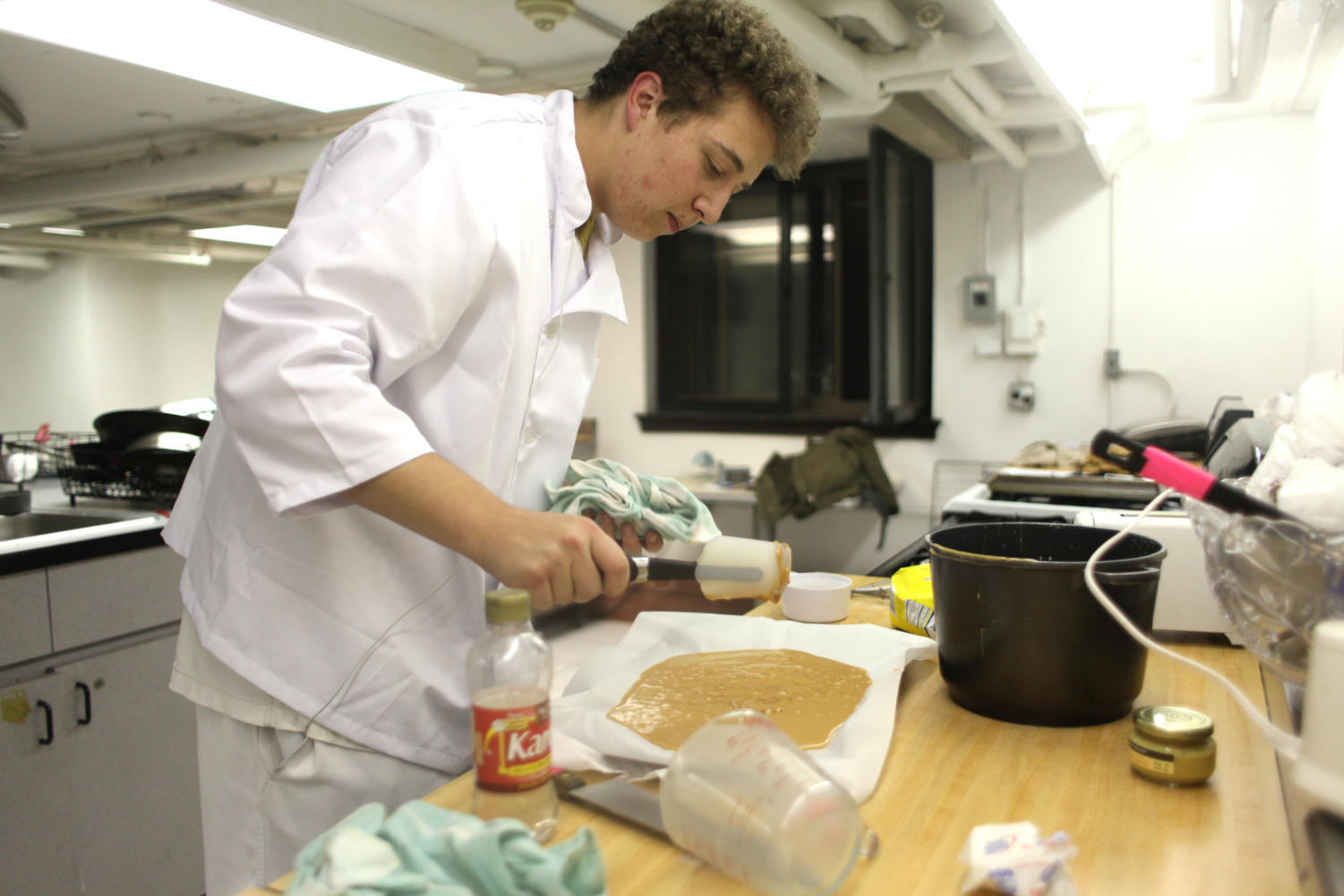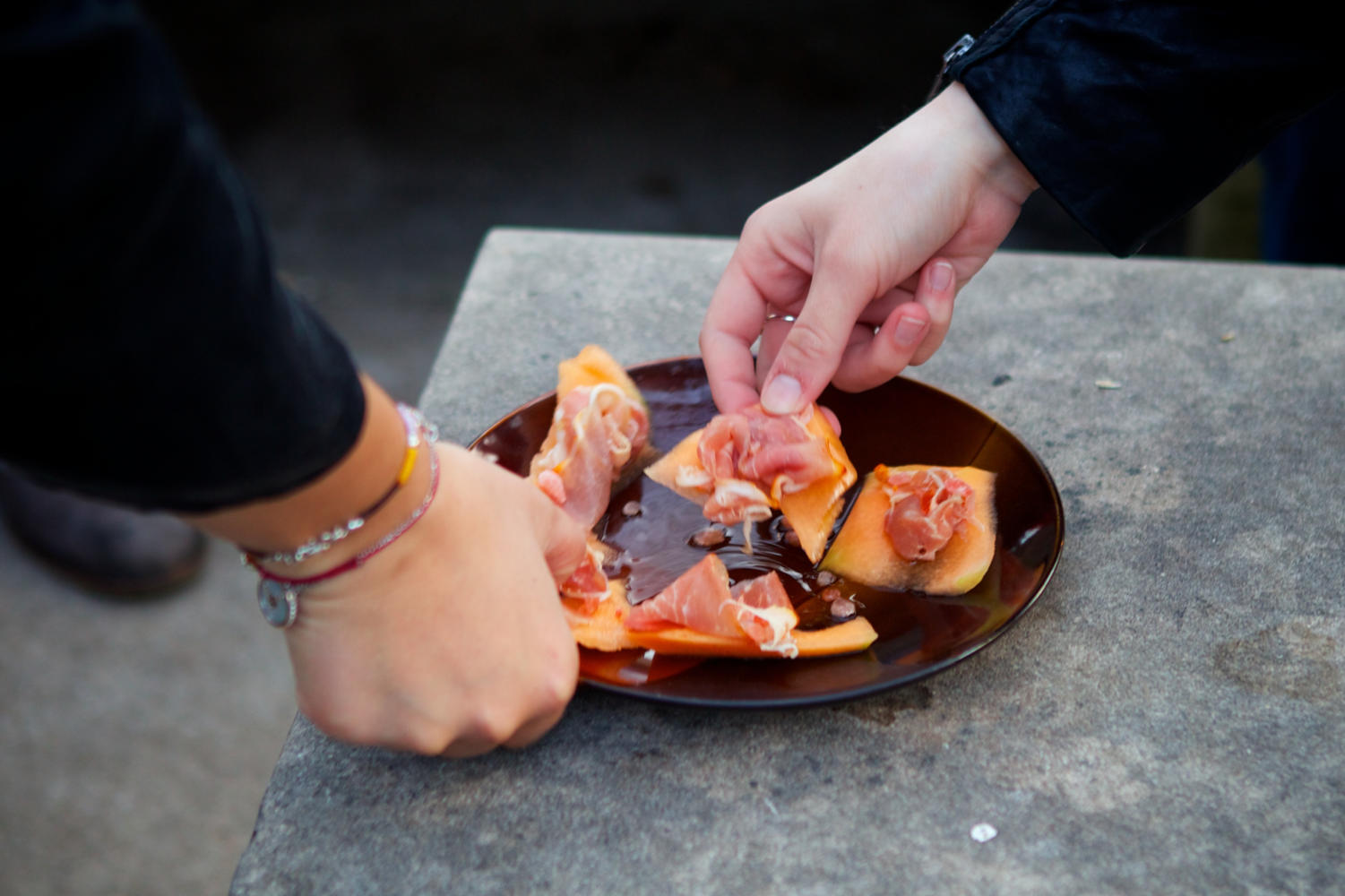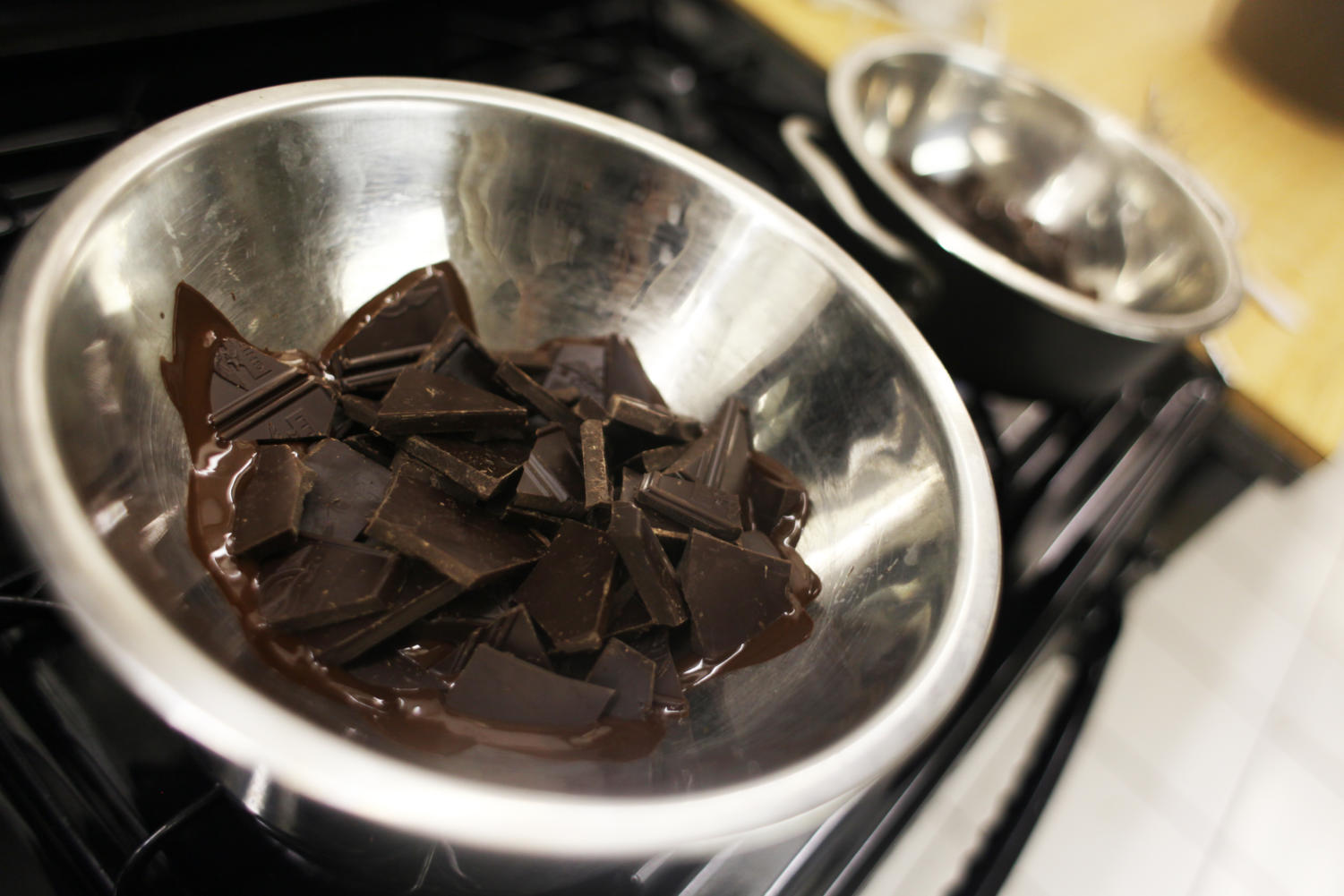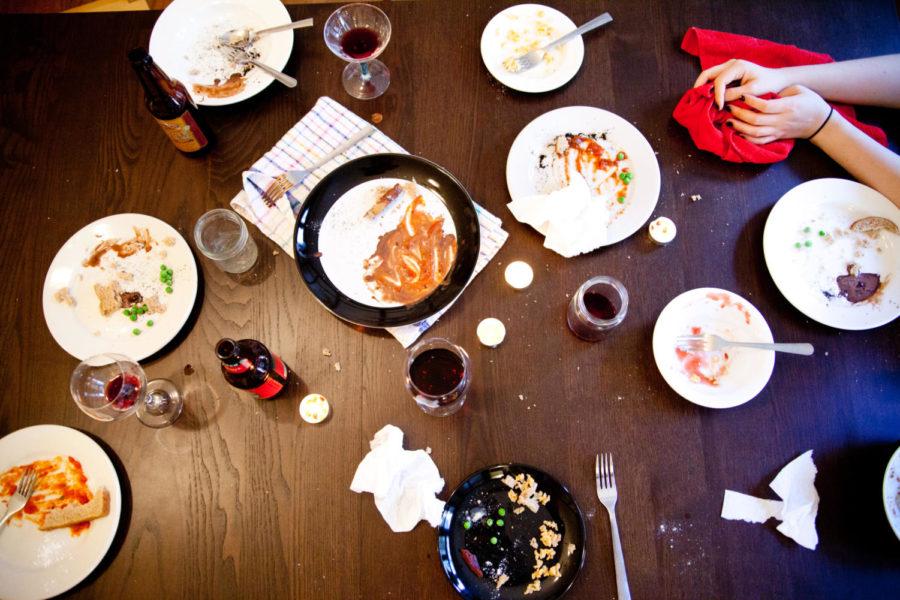“So it’s 6 p.m. on a Wednesday night. And you get an e-mail, and in that e-mail it says something along the lines of, ‘Be in the first floor lobby of the Regenstein library at eight.’”
Robert Lipman stops, allowing himself a small smile that will reappear only when he later recounts bouts of institutionalized rebellion. (“There was a chocolate wine I made using a professor’s centrifuge,” he gushes, shoulders hunched as though he’s whispering about last night’s hookup.)
“You show up, it says, ‘Be here, bring your friend, and I’ll be there waiting.’ At this point—the night of the dinner—you know the day and the time, you don’t know what you’re eating, you don’t know who you’re going to be eating with, you don’t know where it’s going to be, until 6 p.m.”

Ask someone what they think about food culture on campus or who comes to mind when they think of it, and you’ll likely get one of two answers. For the underclassmen, ushered into an era of mystery dinners, Robert Lipman is the go-to. “My friend went to one of his dinners,” they’ll say. “Not me though. I mean, I put my name on the list.”
From an older crowd, you’ll get a slow grin, a faraway look. “The Hearth kid?” they’ll ask, raising an eyebrow. “No. For me, it was Max Chaoulideer.”
The purples of fourth-year Chaoulideer’s hoodie and shoelaces look defiant, and his smile is cocksure when we introduce ourselves. If you previously had any doubts about someone’s capacity to smoke their own bacon and brew their own ale for dinners that served an upward of 50 people, he at once allays your disbelief. Then mocks it.
“It started more or less O-Week of my first year,” Chaoulideer explained of his legacy. “I cooked, like, a huge Persian meal for everyone I had seen. I didn’t even know anyone; it was people I’d like, encountered. And it was awesome.”
If Lipman’s approach to dinners is deliberate and controlled, then Chaoulideer’s is by comparison wild and anarchic. For Chaoulideer, it was about creating “social forums where you could actually, like, have a decent conversation,” the lack of which he was surprised by, given “it’s UChicago.”
After that first dinner, which he staged in Blackstone, his dorm at the time, Chaoulideer gained momentum. Eventually he moved to the I-House kitchen at the suggestions of friends, and “it just got bigger and bigger.” The first-year who cooked impromptu dorm dinners was suddenly the proprietor of an e-mail listhost to which almost one hundred students subscribed. Unlike The Hearth, Chaoulideer’s dinners had an open invitation—all that was required was an RSVP, and you could bring as many guests as you liked.
“What I wanted originally,” Chaoulideer said, “[was] like a little group of my best friends sitting at a table…under pleasant conditions. It ended up being a very different kind of thing. It became a place to meet people, a place for me to cultivate whatever kind of friendships I wanted. That was the main motivation.… Everyone has to eat, so why not eat together?”
It’s a sentiment that pervaded every conversation we had. Food builds community. Community is everything.
***
The same philosophy drives second-year Eric Singerman, who writes for the food blog Serious Eats and who met Chaoulideer last year through the Culinary Club. (He’s been to one of Lipman’s dinners, but never to one of Chaoulideer’s.) Like Chaoulideer, he began cooking communal meals in his dorm, opting for simple and reliable fare like roast chicken, and plans to continue the tradition in his apartment next year.
“I feel like it would be really cool to have random people show up, just friends of friends. I feel like that would be a really organic environment. I mean, no one’s awkward around food, right?” he told us.
Singerman sports flip-flops and has a propensity for shooting our questions back at us. It’s not calculated, though; little about him is. When he stares you down and asks, “What do you think about foodie culture?” it’s with genuine interest.
“I’m not really into the presentation of my food. I like simple things, things that taste like what they are,” he confessed, yanking a foot up onto the opposite knee. “I would shoot myself in the head before I serve a meal as formal as Robert does.”
Food is for Singerman primarily a conduit for social connectivity. “I came to college thinking RSOs, totally, that’s totally how you make friends. But no, not at all,” Singerman said. “I think the [foodie] community can only be centralized by meeting each other, going over to each other’s dinners, hanging out. That’s how you make friends in real life.”
Forging bonds is Lipman’s goal as well, whether despite The Hearth’s formality, or because of it. “This type of thing does not exist at any other university in the world except for here. And this is the perfect place to have an underground restaurant,” he said. “When you see what happens at that table, it almost becomes magical. Like, these strangers become friends.”
Unlike Singerman, however, who specified that these friendships need to be formed in “real life,” Lipman subscribes to the notion that sharing a moment of “magic” will result in ties that bind. During our first conversation, when pressed to give information about his plans for what was then his April dinner, a modern art affair to be held on Botany Pond, his eyes widened. We knew too much. “I’m worried about you guys,” he admitted. “If you haven’t been going, I don’t want to spoil it.”
After all, so much of the experience is about going in blind. “These kids, they really have to trust me,” Lipman acknowledged. “I mean, I don’t tell them anything. They don’t know what they’re going to eat, for crying out loud. I don’t have a food license; they need to trust that I don’t poison them, too.”
While Lipman prepares all his dinners on site, his job extends beyond just the food at hand—to an extent, he’s responsible for the conversations that happen at his table, as well. “I think that if I were in his position I would feel very socially anxious about it,” second-year Olivia Myszkowski, a TEDxUChicago representative who attended Lipman’s latest dinner, said to us over coffee. “You feel responsible, when you bring any sort of group of people together, for them having a normal and fulfilling social experience.”
Lipman auditioned for this year’s TEDxUChicago student speaker competition. He was chosen from a pool of 40, of which he was the only undergrad. Although Lipman (@hearthchef) tweeted that he “was asked” to deliver a TED talk, Myszkowski said, “Robert very much made himself known. That’s not a world I inhabit normally.”
The goal, Lipman said, is to get “these kids to step away for two or three hours, or however long I have them for, and have like, a private little environment.” A dozen people, we noted, is quite a responsibility. Not exactly twelve, he corrected: “I usually keep two seats open for media.… One guy from The New York Times is coming, and one guy from, like, RedEye Magazine.”
“That’s huge. The New York Times will be at your dinner?” we asked.
“They better be. They actually canceled on me once.” Lipman here seemed to reconsider himself. “So if it doesn’t happen then I’ll be very sad. I don’t think it will happen.”
It didn’t happen. The Times cancelled on Lipman once again.
***
Over the past few months, second-year Kirsten Gindler, a Maroon staffer, has been mentally gearing up to become something of a protégé to Chaoulideer. Building off his model, she wants to host dinners in her own apartment next year: “I really want it to be about the food, and people appreciating the food, and preparing the food together.”
Communal preparation is key for Gindler. “I envision people coming together, and I guess, whoever’s planning the meal can announce the menu, and then whoever wants to contribute to the preparation will just show up,” she explained to us. “So many people want to help, so many people want to be part of the food culture at UChicago. So many people are knocking at the door of these initiatives and being turned away.”
For Gindler, a frequent food blogger, exclusivity goes hand in hand with the school of thought that says people should connect over an interest in food, rather than simply over a meal. It’s a notion that for her is emphasizing the wrong thing: “Food is something I enjoy and spend a lot of time thinking about, but I think it’s something that can be enjoyed in good company, and the company has to be formed around other things.” In other words, food provides an occasion, not main event.
Gindler allows that the setup of The Hearth is inherently interesting. “If it generates the enthusiasm, then that’s great,” she said. “But it really doesn’t serve me, or most students.”
Chaoulideer would agree. Speaking about Lipman’s propensity for secrecy, he said the mystery spots are ultimately not for him. “If that works, and he enjoys it, then that’s great, but [in my own dinners] I wanted to avoid things that could be construed as gimmicky, or as, you know, auxiliary. I just wanted good food all the time.”
Lipman’s showmanship has been picked up by the College Web site and Admissions Tumblr. Garrett Brinker (A.B. ’10), director of undergraduate outreach for Admissions, backed up Lipman’s assertion that The Hearth’s efforts are unique to this school. Brinker led us into his quad-facing office, which his colleagues had papered with pictures of his own face. On his whiteboard were written various social media strategies: “Tumblr coffee table,” “Twitter cocktail,” “Facebook backyard BBQ.” He’s been working at the University since graduating, as his LinkedIn reveals. It’s also evident through his accumulation of what one might call UChicago swagger, right down to the sticker on his potted fern.
During our interview, he told a story about a conversation he had with a fellow alum who confessed, “‘I don’t know if I’m interesting, but I know I’m interested. I know I share that with every other student on this campus.’”
“And that’s how we see Robert,” he continued. “We see him as interested, and others as interested in his specific work. We think [The Hearth] is a really fascinating way to create community on campus.… What’s great about this is that you can so easily put a face to the movement. You can really get a true feel for a type of student that exists here.”
***
But there is a glaring absentee from the “movement” that Brinker described: the dining halls, the lowest common denominator of campus affairs, which have received more flack than ever this past year after failing multiple city health inspections.
“I lived in South last year and the dining hall was a bit…” Gindler paused. “Lackluster.”
Chaoulideer, who’s graduating this spring, was less concerned with censorship. Speaking about whether or not he’s seen a change in the dialogue surrounding dining halls over the past four years, he said, “More people are talking about the fact that it sucks.… My first year I tried really hard through various deans and stuff to reform the dining halls. I was so incensed that a university of this caliber would have the balls to serve me this food. I thought, ‘Wow, what an insult.’” And that was before Cathey Dining Commons was temporarily closed, and Pierce and Bartlett both failed health inspections for a host of problems including fruit flies and mouse droppings. “This is a good time to attack,” Chaoulideer said.
Under the qualifier that she’s “somebody who’s not super involved in food culture on campus,” Myszkowski posited a connection between the growing food movement and the “lackluster” campus options. “Part of me feels like this is a reactionary thing to that,” she said.
“When people talk about the dining halls, they don’t really talk about the food,” said third-year Lauren Kelly-Jones. “It’s more like, ‘Oh, I love my house table. I love what came around mealtimes.’”
Kelly-Jones carries herself lithely and works for the Admissions Office as an outreach intern, which means that she, among other things, moderates the incoming classes’ Facebook pages. She said that before Lipman arrived on campus, during the summer of 2012, he would post photos of food he had made on the 2016 Facebook page. “It was definitely Robert, I think, who generated this hype,” she said.
When Lipman launched The Hearth, Kelly-Jones wrote an article about his activities for The Uncommon Blog, Admissions’ official blog. She attended his Valentine’s Day dinner in the Regenstein Library. Lipman served five dessert courses chosen from some of the world’s most famous restaurants (“I’ve never been to any of them, I can’t afford them,” he told us. “But I know everyone wants to go to them.”)
Kelly-Jones is one of the only students who has attended both Lipman’s and Chaoulideer’s dinners. She began going to Chaoulideer’s apartment when she was a first-year, living in housing.
She said she was nervous to go to an unknown apartment off-campus, but then again, later on she also told us about becoming personal friends with a street vendor in Paris whom she now considers “a father figure.”
“I just turned up. Max was in the middle of the chaos, just being Max and cooking this amazing meal,” she said, smiling wistfully. “I used to go every week, it was my favorite thing. And he and his friends just love food, when they talk about it you can just sense they’re just salivating, and it was just such a nice community.”
Kelly-Jones thought of working on an Admissions piece about Chaoulideer, but said it fell through as the frequency of the dinners dwindled, underscoring the fact that while food-centered communities may be meaningful, they’re by no means permanent, often relying on one passionate leader. “I talked about him a lot,” she admitted. “But then everyone got really busy. He got really busy, and stopped doing the dinners.”
***
Kelly-Jones’s experience illustrates a few paradoxes at play within campus foodie culture. It aims to walk a line between dining hall table and party; a free-for-all watering hole that you’ll have a fair shot at actually remembering the next day. A way to engage with your peers honestly—in Chaoulideer’s words, events in which “the goal [is nothing] but just like, hanging out.” Foodie communities, then, seek to satiate a deeper hunger. For a school that prides itself on the life of the mind, creative discourse, and “interested students,” undergraduates never quite seem to get their fill.
It should also be noted that no one we spoke to had any interest in pursuing a food-related career post-graduation. In a conversation with the founders of campus food magazine Nonpareil, second-year Jenny Swann said, “UChicago is not a hospitality school, so I think that it doesn’t necessarily select for people who want to go into the food industry as a function of the way it is. You probably won’t meet a person who wants to open a restaurant.”
While Lipman and The Hearth have most noticeably kept food culture alive for a new wave of UChicago students, there is still a strong current among campus foodies that prompts us to remember that food is more than one chef, one meal, or one unified UChicago brand.
“It’s the difference between the school giving money and the school sponsoring [a dinner],” Singerman said. “It’s like that Shady Dealer article at the beginning of the year about President Zimmer and donuts. Like, there was no President Zimmer, and everyone showed up to that one. People who weren’t normally there. If you take away the school, just donuts, everybody wants to go all of a sudden.”









